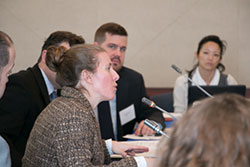Federal Perspectives on Reaching Our Audiences with New Media Tools in 2014

In March, members heard from four key federal leaders about how they are using technology to reach the goals of their programs. Below we provide highlights from each speaker’s remarks.
New Media Use in Response to HIV
AIDS.gov’s Jeremy Vanderlan spoke about use of the Internet for health communication. According to a 2013 report from the Pew Internet and American Life Project, 72% of Internet users say they looked online for health information in the last year. Survey respondents also indicated that the Internet also provides an opportunity to speak to others that share the same health concerns, find online reviews/rankings, and to read or watch someone else’s experience about health or medical issues.
He reiterated the “shareable nuggets” concept explained to us by Susannah Fox. This is information “small enough to get into the bloodstream of social networks.” Because “sharing” is an often used engagement metric, our content has to be tailored to share. It is often easier to communicate an idea through a short picture/video (such as Vine and Instagram) than through a headline.
He also reminded us that “we are not always our audience.” We have to be able to communicate messages so we can also reach people who do not have smart phones or who have lighter access to technology.
White House Approach to Digital Engagement
We were also joined by the Acting Director of the White House Office of Digital Strategy, Nathaniel Lubin. The White House draws on many engaging and interactive ways to share the President’s priorities and agenda. Tools include visual, video, and engaging events. They also focus on transparency as they engage with the public directly. The Office plans ways of using digital media to try to communicate specific information relevant to the audiences that care about the issue. On a given day, it’s very likely that the White House YouTube, Facebook, blog, and Twitter presence will be talking about the same issue. To strengthen the focus on the topic, they focus on how all the channels speak to one another in a way that best leverages the available assets and resources.
NIAID Experience in Social Media
Tori Garten (Chief, New Media and Policy, Web Policy Branch, Office of Communication Development Relations, NIAID) challenged the Council to broaden our perspectives on social media use to think beyond sharing information and how we work together. She emphasized that social tools change how people communicate and change who has voices. We can now communicate with our audiences in different ways. The communication will depend on each agency’s new media and staff resources, its planning processes and its policies. For some agencies that are not comfortable with social media this may mean having a blog that is informational and doesn’t allow comments—as a starting point. Others might have a two way dialogue on their social media spaces all the way up to multi-organizational tools like Thunderclap.
Moving Ahead: Mobile and Resources
Jacob Parcell (Manager, Mobile Programs, General Services Administration) spoke about responsive Web design and the future of government. Mr. Parcell works in the Digital Services Innovation Center which assists federal agencies with standards, practices, and metrics around Web and mobile design. They work to support implementation of the Digital Government Strategy. GSA has consolidated many of its development resources related to social media, mobile and challenges onto DigitalGov.gov. The blog and other resources may interest those outside the USG who are also working on digital innovation.
These speakers reminded the Council that we need to continue to follow communication trends to reach our audiences. Whether government or in the community, we have a responsibility to respond to our audiences’ communication preferences.
What other trends in communication and technology we should watch?This post was originally published on the AIDS.gov blog by Miguel Gomez, the Director of AIDS.gov, and Senior Communications Advisor, Office of HIV/AIDS and Infectious Disease Policy at the U.S. Department of Health and Human Services (HHS).

